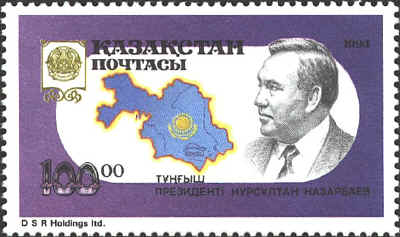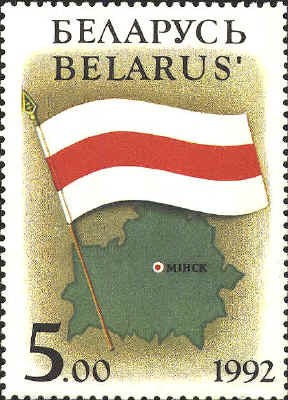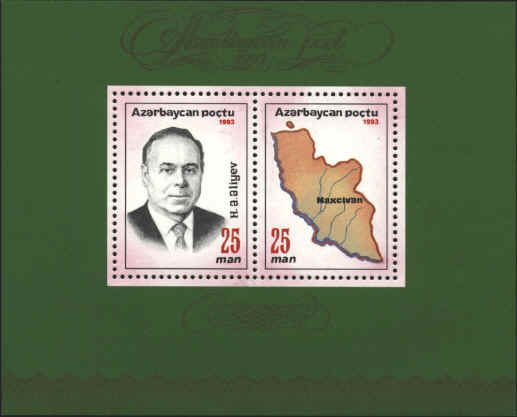|
Kazakhstan
In the
breakup of the Soviet Union Kazakhstan became a member of the
Commonwealth of Independent States in 1991. It is bounded by southern
Russia, Uzbekistan, Kygyzstan and China. The stamps shows a map of
Kazakhstan and a picture of President Nursultan Nasarbajev.

Belarus
When
the Soviet Union collapsed in 1991 eleven former republics asserted
their independence and together formed the Commonwealth of Independent
States. Among the first stamps issued in 1992 by Belarus, formerly
White Russia, were a map of the State and its National Arms. On the
map stamp the capital, Minsk is identified in Cyrillic lettering, and the national flag
is shown.

Azerbaijan
Azerbaijan is the
southernmost part of Russia in Europe. Together with ten former Soviet
republics it established the Commonwealth of Independent States in
1991. The stamp was one of the earliest stamps of the Soviet Socialist
Republic of Azerbaijan issued in 1919. It shows workers and a globe
under the hammer and sickle.

Naxcivan
There are two
territorial anomalies in Azerbaijan. Naxcivan is an enclave of
Azerbaijan separated from Azerbaijan by Armenian territory. Nagorno
Karabakh is a Christian Armenian enclave within Azerbaijan. The
souvenir sheet asserts Azerbaijan's claim to Naxcivan.
In the
early 1990s, after the dissolution of the USSR, the republic of
Azerbaijan attempted to use the Latin alphabet rather than the
Cyrillic. In Cyrillic the letter that looks like an “H” is pronounced
“N.” In 1993 an error was made when the souvenir sheet showing the
enclave of Naxcivan or Nakhichevan was issued. The name of the enclave
was spelled “Haxcivan,” using the Cyrillic “H” for the Latin "N".

Almost
immediately the sheet was reissued with the spelling corrected to
“Naxcivan” in Roman letters.

The
effort in the 1990s to turn to the Roman alphabet was not realized, but in
2001 the Azerbaijani president, Heidar Aliev, ordered that “for
strengthening the country’s sovereignty, in respect for its history
and cultural development, norms of Azerbaijanian language and Latin
alphabet must be kept. All official documents, newspapers and
magazines, as well as advertisements and signs will now be in Roman
letters. The most important scientific and literary works will be
reprinted in Roman letters also."

 |
